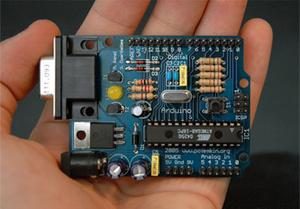I was at a local used computer shop this week, and stumbled across a magazine with a whole bunch of articles on making things with microcontrollers to control them. That got me thinking about my concept of a pitch axis autopilot. I did a bit or research, and determined that while there were dozens of suitable microcontrollers, only the Parallax BASIC Stamp series and the Arduino family have development environments available that run on Mac OS X.
 At the moment, the Arduino seems to be the front runner, as it has some features that the BASIC Stamps don't, such as the ability to directly read analog inputs, which could be useful to allow the gains to be varied in flight during development. The Arduino also seems cheaper, as it comes mounted on a circuit board with power supply, input and output connectors, etc, while the board for the BASIC Stamps is extra.
At the moment, the Arduino seems to be the front runner, as it has some features that the BASIC Stamps don't, such as the ability to directly read analog inputs, which could be useful to allow the gains to be varied in flight during development. The Arduino also seems cheaper, as it comes mounted on a circuit board with power supply, input and output connectors, etc, while the board for the BASIC Stamps is extra.
The Arduino microcontroller has an interesting background - it is the product of an open source development effort. In other words, rather than being developed commercially, it was a collaborative design project between a number of amateurs. Despite the humble beginnings, it seems to be quite a capable device, and perhaps because of the open source heritage, it has development environments that run on Windows, Mac OS X and Linux, whereas most other microcontrollers only support Windows.
I've also discovered that there is a plug-in that allows Python to be used to read and write parametres from the X-Plane flight simulator. In theory, that should allow me to trial various control law algorithms quickly at home, and only flight test the ones that look the most promising. I'll attack this after I get flying.